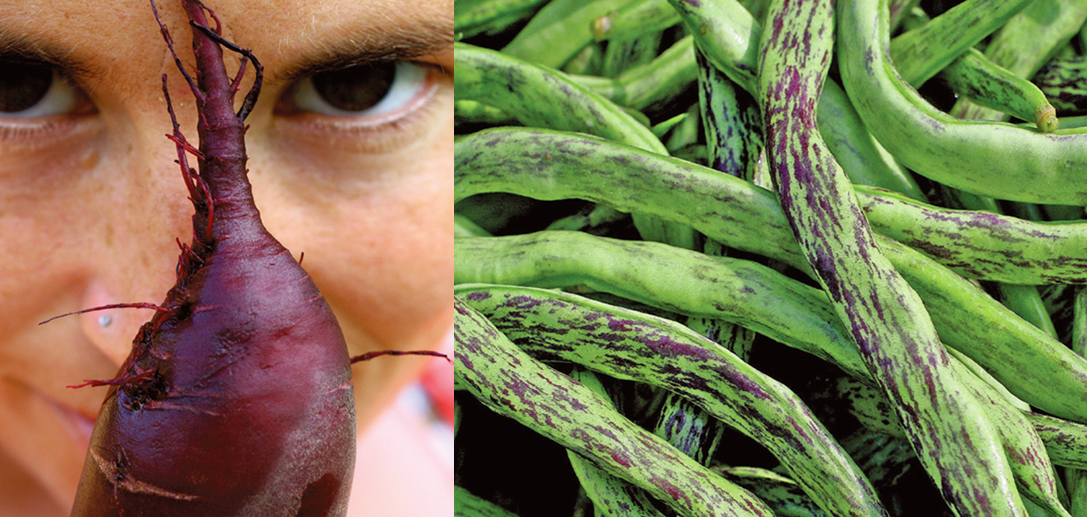Talk Dirty to Me: On Unique Vegetable Varieties, Tomato Supports, and a "Hobbit House" Update
Spring 2014
Farmer Brooke: As I visit farmers’ markets, I notice that many offer unique varieties of familiar vegetables. For example, I once sampled a radish at Badseed that was green on the outside and purple on the inside. In addition to be downright beautiful, it also tasted amazing. As I plan for this year’s garden, I’m wondering if you could suggest some lesser known varieties of common garden crops. What am I missing out on that might please my eye, provide richer nutrients, or pack a flavor better than what I’m used to experiencing from the usual garden suspects?
-Nancy, KCMO
Great question, Nancy. Like most organic vegetable farmers, I have spent many a season trialing unique gourmet varieties of common crops. To win a consistent place in my field, these crop varieties must not only taste divine, but they must perform well in varying weather conditions and produce good yields. In year eight of my farming career, I finally have a foolproof arsenal of over 100 vegetable varieties that produce flawlessly in my field and keep my customers satisfied. I’ve included a list of my all-time top ten favorites. Seeds can be purchased from one or more of the following companies – Fedco Seeds, Johnny’s Selected Seeds, Baker Creek Heirloom Seeds, and Seed Savers Exchange.
Farmer Brooke’s Top Ten Vegetable Varieties For the Midwest Organic Garden
1. Cylindra Beet: These absurdly wonderful elongated beets have rich, smooth flesh that bursts with bold beet flavor, the best tasting dark red beet on the market.
2. Oasis Salad Turnip: These stark white, ultra-sweet turnips can be eaten raw like an apple. They are crisp with melony undertones. They grow quickly like a radish, and will not disappoint… even if you don’t like turnips.
3. White Satin Carrot: Large, crisp, beautifully flavored, glowing white roots that will knock your socks off.
4. Watermelon Radish: This is the amazing radish Nancy mentioned earlier. It gets its name from its fuchsia flesh and green outer rind. Sow in August for a fall harvest.
5. Rossa Di Milano Onion: These sweet red Italian onions steal my heart year after year. They get enormous and store for months.
6. Rattlesnake Pole Bean: Super sweet green beans with striking purple streaks produce a heavy crop until frost.
7. Carmen Sweet Pepper: Lipstick red, horn-shaped peppers so sweet you’ll eat em’ raw in the garden like candy.
8. Sun Gold Cherry Tomato: Everyone’s absolute favorite cherry tomato on the market, prolific and delectable.
9. Japanese Black Trifele Heirloom Tomato: Pear-shaped fruits have brick red skin and deep burgundy flesh and are rich and meaty with chocolate-y undertones.
10. Super Zagross Middle Eastern Cucumber: These Persian delights have juicy, lemony flesh with hints of herbal goodness - sublime!
Farmer Brooke: I need your advice for the best, least expensive tomato supports. The last two years they’ve way outgrown the cages I have and have toppled over. I have increased the size and circumference, and I’m not talking about those wimpy little wire supports. Would you suggest trellising?
-Amanda, KCMO
Amanda, I feel your pain. You absolutely need to ditch the cages and start trellising. Like most of the growers in this area, I use a trellising method known as the “Florida Weave”. … And, no, it’s not a fancy hairdo. You’ll need to plant your tomatoes in a row in order for this to work. There are many variations to this method. The one I am sharing with you is what we do personally at URBAVORE.
Plant your tomatoes two to three feet apart in rows that are four to six feet apart. We do six to provide ample room to maneuver with large harvesting crates, etc. Immediately after planting, sink six feet, or taller, T-posts at the beginning and end of the row and between every third plant. Once the plants are tall enough, about 18 inches, do your first round of trellising using untreated
twine.
Tie the twine securely to the first post and carefully weave it around the first plant and in and out of the subsequent plants, pulling as tightly as you can and triple wrapping around each post as you go to prevent loosening. Once you’ve completed one side of the row, cut and tie the twine off securely. Then, begin down the other side creating a sandwich effect as you weave in and out of the plants.
This method works great if you keep up on it. Another round of trellising should be added every week or two. We use the notches on the T-Post as a gauge and add another line every fourth notch. I know this sounds confusing. It is much better understood with pictures or diagrams. The following link is really helpful, and it is directed towards home growers with limited space as opposed to commercial farmers. I think you’ll find it useful. http://www.gardenbetty.com/2011/08/trellising-tomatoes- with-the-florida-weave/
Farmer Brooke: What issues are you running into building your Hobbit House, and what materials are you using to construct it? I’m very interested in doing something similar on my property.
-Richard, Lawrence, KS
Before I answer Richard’s question, I’d better back up and explain what our “Hobbit House” is and the nature of the project in general. My husband and I are in the process of building a passive-solar earth-bermed home on our 13.5-acre urban farm just five miles east of the Country Club Plaza. The house sits in the belly of the earth on top of a hill looking over the farmscape and the surrounding city. Earth covers the entirety of the north wall and continues over the roof. The east and west walls are constructed entirely of windows, allowing adequate air flow and the luxury of seeing the sun rise and set, and the south wall is bermed with earth six feet up, at which point clerestory windows create a green house effect. Due to the savvy design of the house we have no need for supplemental heating or cooling. All electrical needs will be solar powered. Water will be pulled from our quarter-acre pond and filtered through sand and UV filtration. All water leaving the house, both gray and black water, will be filtered again through sand and UV, using a specially designed “green” septic system, and stored in a cistern for watering livestock, field crops, and green house seedlings. A composting toilet will handle all solid waste. The finished compost will be used to enhance ornamentals
and landscaping.
In essence, our home and farm will be completely self-sufficient, and we will never pay a utility bill again. Now, while all this sounds simply ideal, the reality of implementing such a thing has been difficult beyond explanation. We do not live in a day and age where sustainable/ alternative lifestyles are embraced. Our city’s building codes are a prime example - cookie cutter homes made for cookie cutter people is the name of the day. Energy efficiency, environmental responsibility, and creative thinking are grounds for serious complication. Throw in recycling your own poop, and all hell breaks loose!
If we had been building such a home in a rural area without municipal building codes, the process would have gone much smoother. We would have had more options for non-toxic, earth friendly materials, and we would have spent a lot less time and money entangled in bureaucracy and permitting. So, without a doubt, city building codes have been our number one issue. We’ve been navigating codes and working with the city at length at every step of our project for over a year. While problem solving with the house design was intense, dealing with the challenges posed by offgrid systems has been even worse. A lot of money has been spent in order to tweak our systems so that they pass code, and, in other instances, we’ve been granted code modifications.
Uncompromising ethics and sheer relentlessness have gotten us to the point we are at today – an almost completed shell with electric and plumbing underway. Concrete forms the majority of the house, which meets both the structural guidelines of the City, and the physical demands of our oppressively humid, freezing and thawing Midwestern climate. More alternative materials, such as rammed earth or cob, would never have passed code - straw bale may or may not. Concrete footings and concrete walls retain the weight of the soil that encompasses them. Massive glulam beams provide the roof with the strength needed to hold a foot of soil. The windows are high performance, insulating glass with varied tinting to prevent or facilitate solar gain. We are reclaiming glass, trim lumber, interior finishes, and just about anything else we can.
I highly encourage everyone to strive for greener homes and simpler lives. You don’t necessarily have to go to the extremes that we have to do so, nor do I think it particularly achievable. What is attainable, however, is retrofitting your current home with sustainable systems. We couldn’t believe how affordable solar has become, especially with the rebates available within our region. There are now recommendations for gray water in the International Residential Code, which almost every city uses for their building code. Manufactured composting toilets are on the markets and can be installed in any home. There are tons of options!
For those of you that want to go our route, research your municipal building codes. But, more than that, clearly outline what it is you hope to achieve with your dwelling, be it low toxicity, energy efficiency, simplicity, beauty, or all of the above. Determine what you refuse to compromise on and go from there. I truly hope that once completed, the “Hobbit Home” can serve as a resource to help and inspire others and streamline a daunting and difficult process.
We plan to publish an on-line guide that details our project step-by-step. This guide should help people trouble shoot and avoid many time-consuming and costly mistakes. Good luck Richard! I’m happy to give you a tour of our semi-completed home when time permits.
Send your gardening, homesteading, cooking, and “green” lifestyle questions to askbrooke@ediblekansascity.com.





